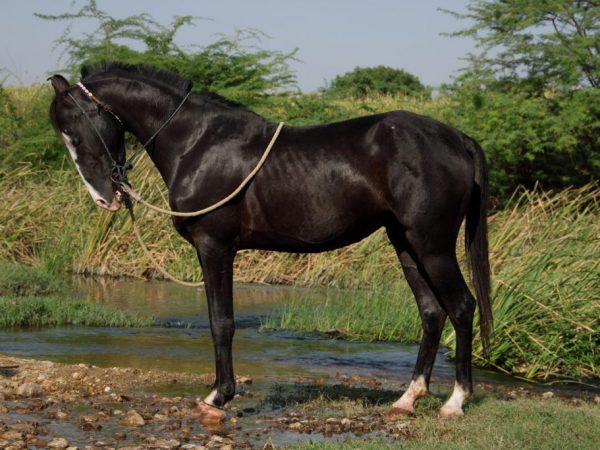Description of the Marwar horse
The Marvari horse, or Marwari, is an ancient breed of horses. Its representatives are short, because of this, some confuse such individuals with ponies. This breed was bred back in the Middle Ages. The origin of Marwari is associated with the Indian city of Marwar, hence the original name.

Marwar horse
How did this breed appear?
In the Middle Ages, those who ruled the Marwar region began breeding this breed. This was the XII century, and breeders were already actively taking care of the horse to be of pure blood, to develop its endurance. Horses were selected for breeding this breed according to very strict rules. In cavalry times, these horses found their direct purpose: in battles, the rider felt very confident, since by the nature of the Marvari they were distinguished by courage and loyalty.
Today, scientists hypothesize that the great-grandfathers of this horse are horses from countries such as Afghanistan, Kazakhstan, Turkmenistan and Uzbekistan. The blood of Arabian horses and horses from Mongolia also flows in their veins, similar features can be found in the external characteristics of the listed individuals, and if you put photos of all the listed species in one row, you can be convinced of this. However, there is something that none of the great-grandfathers have: the interesting shape of the ears, which resembles a heart. This feature, again, is clearly visible in the photo.
Previously, the Marwar horse was actively involved in battles and was used for riding, but only privileged people could ride it.
In the twentieth century in India, this breed was mishandled, which led to a decrease in the population. This is no longer a problem today. However, Marwari are still rare horses. It is not so easy to acquire them. The fact is that these horses are forbidden to be exported outside India. It was only in 2000 that it became real.
Exterior and character
The Marwar horse has an original character. She has a very well developed intuition, this leads to the fact that the Marwar horse can easily return home. This ability has helped Marwari more than once and even saved her life.
The breed has well developed all the senses: hearing, sight, smell. This means that the horse can identify an impending dangerous situation. Loyalty is also characteristic of this breed: even a wounded horse will not abandon its owner in trouble.
The representatives of the breed have an average height, which is 152-163 cm, which is also noticeable in the photo. But it must be said that if the horse comes from certain regions of India, then its height may be slightly above average.
This horse is characterized by a large head and a straight profile. The ears are quite long: from 9 to 15 cm - they can be turned 180 °. The neck is distinguished by its length, the withers are well formed. The horse is characterized by straight shoulders, which makes it easy for the animal to move through the desert: the Marvar horse easily frees its legs from deep sand. Of course, this slows down the speed, but at the same time the rider feels normal from above.
Suit
These Indian horses can be of different colors, but the most common are red horses. Gray and piebald colors are very much appreciated. The black color of the horse symbolizes death. each of the tones can be seen in the photo.
Indians believe that the Marwar horse:
- black can promise trouble for its owner;
- with white socks and spots will surely bring happiness to the owner.
White horses in India are bred for religious purposes.
Application of Indian horses
These Indian horses are used in almost all areas. A rider can learn to ride using this breed, if necessary, this horse will also serve as a draft horse. Marwari can also safely harness the crew. The animal is also used for agricultural purposes.
The described horses are remarkably amenable to training, they have very beautiful graceful movements. In equestrian polo, you can also find this breed: a horse can be put up without fear even against a thoroughbred horse. There is a variety of photos on the network that testify to the versatility of such horses.


